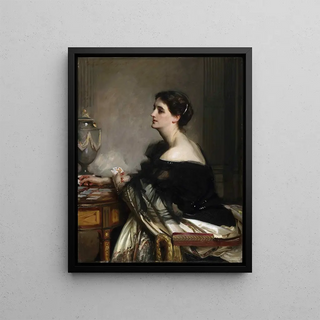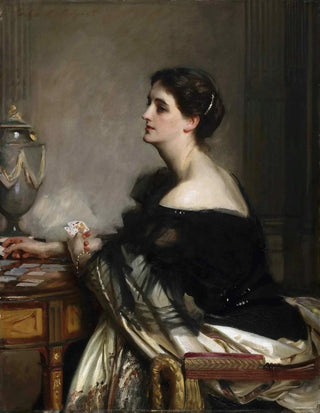Art print | Sybil Frances Grey, later Lady Eden - John Singer Sargent


View from behind

Frame (optional)
The artwork "Sybil Frances Grey, later Lady Eden" by John Singer Sargent is a true masterpiece embodying the essence of portraiture at the end of the 19th century. In this painting, Sargent captures not only the beauty of his model but also an atmosphere filled with emotion and personality. Sybil Grey, a young woman from British high society, is depicted with a grace and elegance that transcend a simple portrait. The soft light caressing her face and the refined details of her dress evoke a rare intimacy, inviting the viewer to delve into the private world of the sittee. This piece, both classic and bold, demonstrates Sargent's skill in blending technique and sensitivity, making each painting a window into the human soul.
Style and uniqueness of the work
Sargent's style is characterized by an unparalleled mastery of color and light. In "Sybil Frances Grey, later Lady Eden," he uses rich tones and subtle contrasts to create a vibrant and lively atmosphere. The texture of the painting, almost tangible, enhances the impression of realism while maintaining a certain fluidity that defines his work. The artist moves away from rigid conventions of academic portraiture, favoring a freer and impressionist approach. The details of Sybil's dress, for example, are rendered with a lightness that suggests movement, while her serene and confident expression captures the essence of her personality. This work stands out for its balance between faithful representation and artistic interpretation, offering a unique vision of its subject.
The artist and his influence
John Singer Sargent, born in 1856, is one of the most renowned portraitists of his time. Trained in Paris, he absorbed impressionist influences while developing a personal style that is uniquely his own. Sargent painted many emblematic figures of high society, capturing not only their appearance but also their character. His work had a significant impact on the art world, inspiring generations of artists to explore the limits of portraiture. The way he manages

Matte finish

View from behind

Frame (optional)
The artwork "Sybil Frances Grey, later Lady Eden" by John Singer Sargent is a true masterpiece embodying the essence of portraiture at the end of the 19th century. In this painting, Sargent captures not only the beauty of his model but also an atmosphere filled with emotion and personality. Sybil Grey, a young woman from British high society, is depicted with a grace and elegance that transcend a simple portrait. The soft light caressing her face and the refined details of her dress evoke a rare intimacy, inviting the viewer to delve into the private world of the sittee. This piece, both classic and bold, demonstrates Sargent's skill in blending technique and sensitivity, making each painting a window into the human soul.
Style and uniqueness of the work
Sargent's style is characterized by an unparalleled mastery of color and light. In "Sybil Frances Grey, later Lady Eden," he uses rich tones and subtle contrasts to create a vibrant and lively atmosphere. The texture of the painting, almost tangible, enhances the impression of realism while maintaining a certain fluidity that defines his work. The artist moves away from rigid conventions of academic portraiture, favoring a freer and impressionist approach. The details of Sybil's dress, for example, are rendered with a lightness that suggests movement, while her serene and confident expression captures the essence of her personality. This work stands out for its balance between faithful representation and artistic interpretation, offering a unique vision of its subject.
The artist and his influence
John Singer Sargent, born in 1856, is one of the most renowned portraitists of his time. Trained in Paris, he absorbed impressionist influences while developing a personal style that is uniquely his own. Sargent painted many emblematic figures of high society, capturing not only their appearance but also their character. His work had a significant impact on the art world, inspiring generations of artists to explore the limits of portraiture. The way he manages






